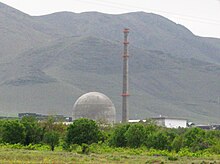IR-40
Coordinates: 34 ° 22 ′ 24.3 " N , 49 ° 14 ′ 26.8" E

IR-40 is a research reactor under construction northwest of the Iranian city of Arak . It is a heavy water reactor with a thermal output of 40 MW that works with natural uranium . Iran has its own uranium deposits. The main purpose of the IR-40 plant is the production of radionuclides for medical and industrial purposes. These include the isotopes cesium-137 , cobalt-60 , iodine-131 , iridium-192 , molybdenum-99 and yttrium-90 .
Originally, the reactor was to be built in Isfahan , but once the planning was complete, the Iranian government decided to move the site to Arak. On May 5, 2003, the International Atomic Energy Agency (IAEA) was informed about the construction project. The news magazine Der Spiegel published a satellite image in January 2007. An IAEA inspection was announced on July 25, 2007. IAEA Director Mohammed el-Baradei criticized the uranium enrichment program and the continuation of the construction of IR-40 in September 2007.
Technology, construction, operational purpose
There is no reliable information about the construction, but from various details that have become known it can be concluded that it is very likely a pressure tube reactor . These details are e.g. B.
- separate heavy water circuits for moderation and cooling, as with the CANDU reactors,
- the great similarity of the fuel element made in Iran - of which there is a published picture - with the fuel element of RBMK reactors.
A pressure tube reactor is well suited to continuously extracting weapons plutonium in addition to the actual reactor operation . Therefore, Israel sees itself threatened by the plant at Arak in connection with the entire Iranian nuclear program .
The government denies the development of nuclear weapons; the nuclear program only serves peaceful purposes.
In November 2013 the following was agreed in an agreement in Geneva:
- no further work on the heavy water reactor in Arak
- Disclosure of all Arak records
- no fuel reprocessing program
On December 8, 2013, a report was published on a visit by UN experts. On December 28, 2013, Ali Akbar Salehider, head of the Iranian Atomic Energy Agency , stated that the reactor at Arak was not suitable for the production of weapons-grade plutonium because the fuel elements would remain in the reactor for a year. After more than three or four weeks, the plutonium can no longer be used for nuclear weapons. In addition, Iran has no facility to separate the plutonium.
As part of the agreements between Iran and Western powers in April 2015 in Lausanne , the Iranian side is said to have promised not to finish the IR-40 in the intended construction, but to modify it so that it is not suitable for the production of weapons plutonium.
Individual evidence
- ^ A b Willig, Thomas Mo: Feasibility and benefits of converting the Iranian heavy water reactor IR-40 to a more proliferation-resistant reactor . In: masteroppgåva . Norwegian University of Life Sciences (UMB). December 14, 2011. Retrieved June 9, 2013.
- ↑ Newspaper report: Israel is supposed to plan a nuclear strike against Iran. In: Spiegel Online . January 7, 2007, accessed June 10, 2018 .
- ↑ http://www.iaea.org/newscenter/news/2007/arakvisit.html
- ↑ http://www.iaea.org/newscenter/news/2007/dg_gcstatement.html
- ↑ Gero von Randow: Iran's nuclear program: After the deal is before the deal. In: Zeit Online. November 24, 2013, accessed December 15, 2013 .
- ↑ Iran: UN experts examine nuclear reactor in Arak. In: Spiegel Online . December 8, 2013, accessed June 10, 2018 .
- ↑ http://www.channelnewsasia.com/news/world/arak-reactor-cannot-make/935822.html
- ↑ spiegel.de Negotiations in Lausanne: Breakthrough in the nuclear dispute with Iran (accessed on April 3, 2015)
- ↑ spiegel.de nuclear agreement with Iran (accessed on April 3, 2015)
